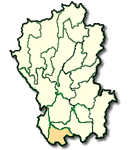Uthai Thani Province in Northern Thailand

Uthai Thani is situated in the lower part of the northern region. Recent excavations have indicated that this area was inhabited by prehistoric people. There are several places of interest but because the town is far from the main highway few visitors make the trip to this province.
Uthai Thani occupies a total area of 6,730 square kilometers located 219 kms. from Bangkok. It is divided into 8 Amphoes; Muang, Nong Kha Yang, Nong Chang, Thap Than, Ban Rai, Sawang Arom, Lan Sak and Huai Khot.
What to see and what to do in Uthai Thani?
Wat Sangkat Rattana Khiri is situated at the foot of Khao Sakae Krang. A very beautiful Buddha from the Sukhothai period named "Phra Mongkhon Saksit " is housed here. This Buddha image is cast of bronze in the attitude of Subduring Evil. It is one of the most sacred Buddha images and is highly revered by Uthai Thani residents. Crowds of Buddhists assemble for the "Tak Bat Thewo" (Merit Making Festival) at this temple every year on Ok Phansa Day.
Khao Sakae Krang Buddha Footprints are enshrined on the 120 meters summit of Khao Sakae Krang near Wat Sangkat Rattana Khiri. The mondop covering the Footprints was built in the year 1905 and renovated in 1968. A Fair celebration the Footprints is held from the third day through the eighth day of the waxing moon in the fourth lunar month of each year.
Mural Paintings at Wat Ubosatharam, situated on Ko Thepho opposite Uthai Thani Province Market is commonly called "Wat Bot". The early Rattanakosin period mural paintings on the walls of the main shrine hall are very beautiful. Paintings of divine beings are on the upper part while scenes from the life of the Lord Buddha decorate the lower part of the wall.
History and Local Culture Museum, Located at Uthai Thani nonformal Education Center, the museum puts on exhibition pre-historic human skeletons, local costumes and governor's costumes. etc.
Khao Pathawi
This mountain is situated at Tambon Talukdu, Amphoe Thapthan, 38 kms. from township area. It resembles the picturesque mountains depicted on Chinese porcelains. It has cool ample space with shady trees and is inhabited by groups of monkeys. There are many caves inside the mountain including the Tham Prathun and Tham Rusi (or Hermit Cave) with many beautiful stalagmites and stalactites.
Tham (cave) Khao Phraya Phai Rua
This newly discovered cave, is situated in Amphoe Lan Sak, 60 kms. from the township ares. Viewed from a distance, the hill resembles a Chinese junk surrounded at the base by a natural moat about 12 meters wide. The sides of the mountain are covered with many species of trees. Inside the mountain there are many caves such as Tham Kaeo, Tham Si Chomphu, Tham Thong Phra Rong, Tham Buddha Sathan and Tham Ang Nam Mon, each with its own particular beauty. Some of them are adorned with beautiful stalagmites and stalactites. A visit to the caves will require some 4-5 hours to see all the interesting sights. There is electricity for illumination in the caves. The authorities should be contacted in advance to light the caves and payment must be made for the cost of the electricity.
Huai Kha Khaeng Wildlife Sanctuary
This area, bordering Changwat Uthai Thani and Changwat Tak, was declared a wildlife preserve in 1972. The FAO is presently making a survey of the area and will open it as the most complete and biggest wildlife sanctuary in Southeast Asia. Generally, this area consists of virgin forests, cleared forests, prairies and many streams. It is suitable for wildlife breeding. Here can be found many species of wild animals including rare and nearly extinct species.
Huai Kha Khaeng can be reached by taking Uthai Thai - Nong Chang - Lansak Route (Highway No. 3438) to Km.53-54, then turn left for another 14 kms. However, prior approval is necessary from the Wildlife Conservation Division, the Royal Forest Department, Tel. 579-4847. Important considerations for the jungle trekker are a Tour guide, food and medicine.
Tak Bat Thewo
"Tak Bat Devo" means to fill the bowls of the gods. In this festival, held a day after Ook Phansa (Buddhist Rains Retreat about October each year), monks descend from a hilltop temple to receive offerings from local people, as the Buddha himself is believed to have done after preaching to his mother in heaven. Folk theatre and other entertainments are also provided.
